BEST VALUE PLOW
COMPLETE PLOW SYSTEM IN 1 BOX.
ATV - $369.99 / UTV - $469.99
Universal and complete ATV & UTV standard plow system that contains everything to start plowing today in 1 box.
Blades can be adjusted and set to 2 different widths.
|
Lift Height |
10 inches |
|
Underbody Mid Mount |
✔ |
|
Assembly Time |
60-75 minutes |
|
Power Angle (Optional Accessory) |
✖ |
|
Construction |
Bolted Construction |
|
Quick Attach |
✔ |
View Comparison Chart
BEST SELLING ATV PLOW
FIND THE SNOW, PLOW AWAY
$514. 97 - $739.97
These push tubes have been pushing snow around for years, and deservedly acquired a very suiting nickname: Storm Chaser.
These push tubes are workhorses, designed with the same heavy-duty square tube chassis as big brother, High Rise, but without the lift height of power angling capabilities.
|
Lift Height |
10 inches |
|
Underbody Mid Mount |
✔ |
|
Assembly Time |
30-45 minutes |
|
Power Angle (Optional Accessory) |
✖ |
|
Construction |
Welded Construction |
|
Quick Attach |
✔ |
View Comparison Chart
|
Lift Height |
21 inches |
|
Underbody Mid Mount |
✔ |
|
Assembly Time |
30-45 minutes |
|
Power Angle (Optional Accessory) |
✔ |
|
Construction |
Welded Construction |
|
Quick Attach |
✔ |
View Comparison Chart
|
Lift Height |
30+ inches |
|
Bumper/Front Mount |
✔ |
|
Assembly Time |
30 minutes |
|
Power Angle (Optional Accessory) |
✔ |
|
Construction |
Welded Steel Construction |
|
Quick Attach |
✔ |
Utility September 15, 2021
Once snow starts piling up, ATV and UTV owners have a leg up over those wrangling shovels and snow blowers by hand.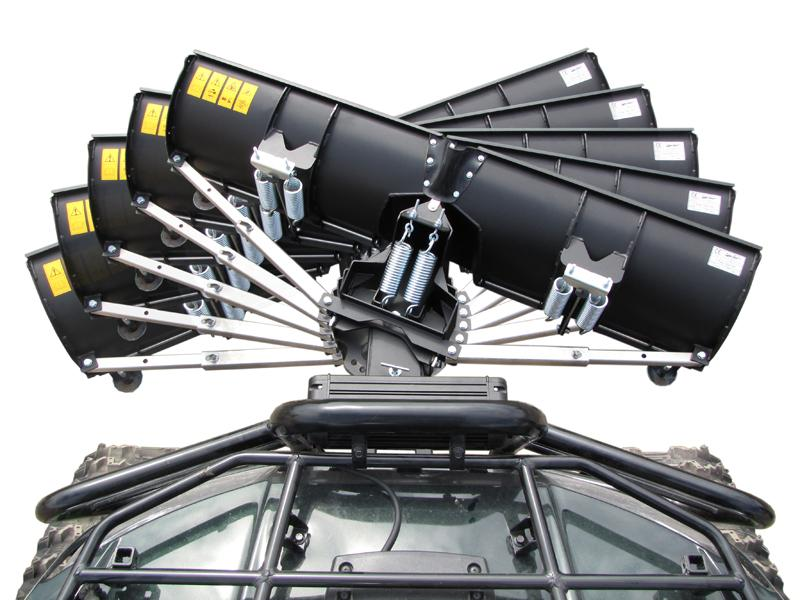 Outfitting your off-road vehicle (ORV) with a snow plow makes winter your playground: You no longer need to fear those blizzard-ridden forecasts. Rather, you might even start looking forward to them! After all, keeping your driveway or access roads clear when you’ve got a plow on your rig is not only a breeze: It can also be downright fun.
Outfitting your off-road vehicle (ORV) with a snow plow makes winter your playground: You no longer need to fear those blizzard-ridden forecasts. Rather, you might even start looking forward to them! After all, keeping your driveway or access roads clear when you’ve got a plow on your rig is not only a breeze: It can also be downright fun.
A full winter workout of plowing requires that your ATV or your UTV is in tiptop shape, especially considering the extra load shoving and piling snow puts on your machine. Take time before the snow comes to give your ORV a thorough once-over and tend to any major upkeep issues. Many riders do this in the fall while the weather’s still pleasant, which helps them roll into the plowing season with a bit more confidence to tackle what Mother Nature throws their way.
During the winter plowing season, you’ll still want to stay on top of the routine inspections and maintenance you should be carrying out whenever you use your machine. Make sure fluid levels are adequate.
You’ll also want to make sure you’ve equipped your four wheeler or side by side (SxS) with the proper tires to handle well in snow. Tracks may be helpful in improving your traction in areas with extreme snowfall.
Check your owner’s manual to make sure your machine is powerful enough to wield a plow and shove and haul snow. An underpowered machine may simply be unable to push through drifts; it may also suffer expensive damage from being overtaxed. A bigger engine can handle larger plows and heavier snow.
When it comes to ATVs vs. UTVs for snow plowing, context matters. If you’ve got just a small walkway or driveway to keep clear, a narrow ATV outfitted with a small plow may do just fine. For bigger driveways, access roads, and other larger areas, a UTV capable of handling a heavier, wider plow is often the better route.
For bigger driveways, access roads, and other larger areas, a UTV capable of handling a heavier, wider plow is often the better route.
Keep in mind there are different strategies for snow-plowing with an ORV, from directly pushing snow into heaping drifts to angling it into windrows you maintain all season long.
Just going out and powering through the snow with your 4-wheeler plow may not be the right approach. Make sure you’re paying attention to the thickness of the snowpack and adjusting the plow depth accordingly: You don’t want your plow blade to be digging into bare earth or pavement. If you’re in a climate where snow tends to accumulate throughout the winter, you’ll likely be lowering your plow over time; early in the season, or when snowpacks are scanty, keep your plow higher.
You also want to keep in mind the aspect or incline of the ground you’re plowing.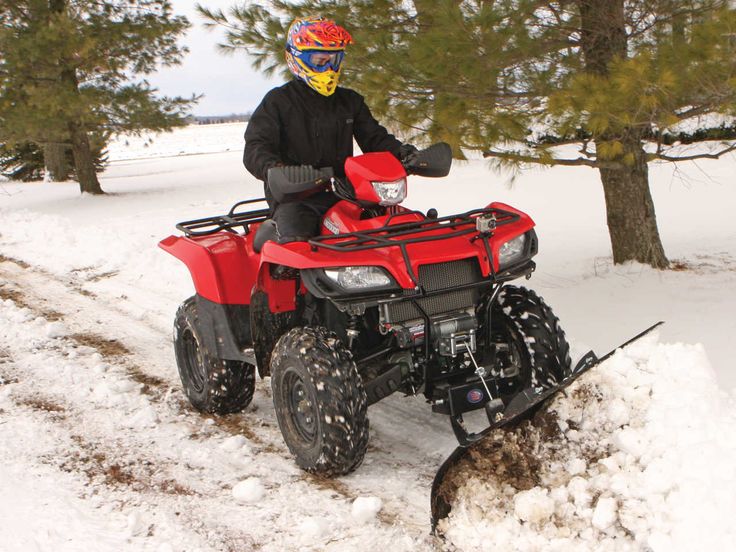 A driveway, for example should ideally slope a little bit away from your garage or house. Here’s where adjusting the angle of our plow comes into play.
A driveway, for example should ideally slope a little bit away from your garage or house. Here’s where adjusting the angle of our plow comes into play.
Besides considering the amount of space you’re likely to be plowing, think about the amount of snow your location typically receives as well as its relative wetness. More and/heavier snow may require a bigger engine and larger ORV.
While we’re discussing the depth and angle of your snow plow, we’ll throw in an extra tip about avoiding mishaps or all-out disasters. Before the snow falls, make sure the areas you’ll be plowing are clear of as many obstacles as possible, and mark permanent obstacles such as retaining walls, well heads, prized garden beds, and the like with reflective or flagged poles.
After you’ve wrapped up your plowing for the day, the job’s not done: You want to clean off the plow attachment and stow it correctly to minimize the chance of damage.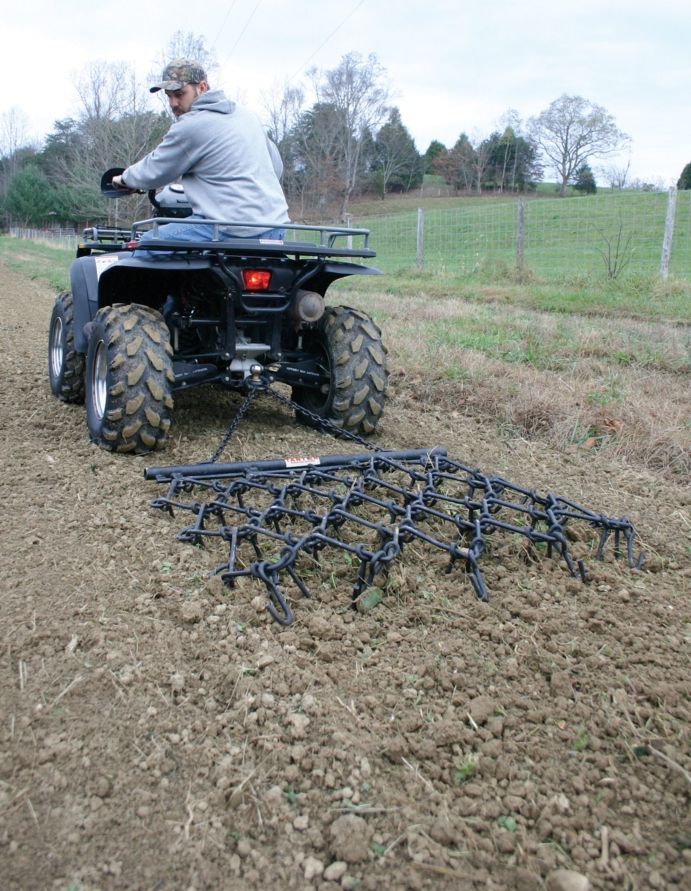 Knock or wipe off any snow, ice chunks, or dirt that are clinging to the plow; left on, they may freeze and become that much harder to dislodge, as well as encourage rust on the blade. Lower the plow to the ground when you park to avoid unnecessary strain on your machine’s winch and suspension.
Knock or wipe off any snow, ice chunks, or dirt that are clinging to the plow; left on, they may freeze and become that much harder to dislodge, as well as encourage rust on the blade. Lower the plow to the ground when you park to avoid unnecessary strain on your machine’s winch and suspension.
Think your quad or UTV is only useful on those spring-through-fall trails? Think again: You can put that ORV to work all winter long with the right plow attachment and associated accessories. Choose the right plow and accessories, and you’ll be the neighborhood hero.
Mini-all-terrain vehicles have recently become increasingly popular among fans of extreme sports. If you also have a plow for an ATV, then this small SUV will not only be a way to get an adrenaline rush, but also an indispensable assistant in cultivating the land of the site where your garden is located.
If you also have a plow for an ATV, then this small SUV will not only be a way to get an adrenaline rush, but also an indispensable assistant in cultivating the land of the site where your garden is located.
This technique originally appeared as a means of entertainment, and it served for traveling over rough terrain, overcoming hills, water obstacles and off-road. A wheeled tractor was taken as the basis, only, unlike it, the SUV was already initially created more maneuverable and stable.
The off-road vehicle was calculated not for plowing hectare areas and transporting multi-ton cargo, but specifically for the needs of one person. Even the smallest ATV has a few horsepower.
ATV trailers and attachments easily transform them from off-road racing and overcoming obstacles into conscientious hard workers.
All this will significantly increase the efficiency of processing your site, where a garden house or cottage is built. Having fully understood and mastered all its possibilities, you will no longer be able to imagine how you managed without it before.
Having fully understood and mastered all its possibilities, you will no longer be able to imagine how you managed without it before.
ATV, if desired, will not only allow you to have fun while riding it, but also significantly help in the household. It will not only save your labor costs, but also save a lot of money. With the proper trailer and attachments for it, you can perform the following work:
Plowing and harrowing of the earth is required for anyone who has a private plot. Moreover, allotments can be located in places where an ordinary tractor simply cannot climb or cannot fully plow them due to the small area, because it simply has nowhere to turn around. The strength and agility of this machine come to the rescue.
ATV plowing tool is designed as a conventional cultivator for commercial-scale agricultural tractors. Only it is smaller and consists of one knife, a maximum of two.
Only it is smaller and consists of one knife, a maximum of two.
The blades are mounted on a trailed frame supported by one or two wheels (depending on the chosen design), which can be raised or lowered as required by a winch mounted on the ATV itself. The frame is attached to the ATV. Its connection occurs with the help of a towbar.
ATV plow, like all such earthwork tools, consists of:
ATV plow blade is made of extra strong steel and has different sharpening depending on the chosen angle of deepening and turning of the raised ground.
When the plow moves, the cropped land is lifted by leaning on the working plane, the dimensions of which are selected depending on the desired plowing depth.
The blade is followed by a plowshare that begins to turn the soil layer.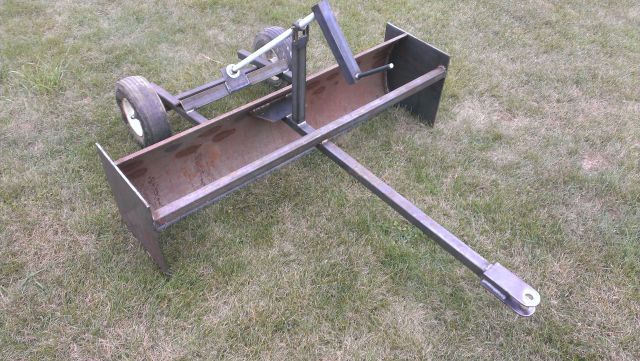 It is usually made in a curved shape, especially for turning the turf.
It is usually made in a curved shape, especially for turning the turf.
Next comes the blade itself, which is a plate that finally turns the soil by 180°. The whole structure is mounted on a rack attached to the frame. The frame is attached to the ATV.
Special disc coulters can also be attached to this structure to facilitate the plow's entry into the soil and its further loosening. There can be one or two of them, and they can be located in front or on the side directly from the plow itself.
As a rule, organizations selling this equipment immediately offer all additional accessories in the kit, allowing you to make the most of its capabilities. Of course, an ATV plow bought right away is the best solution, but you can make it yourself using just a few steel parts.
Starting to make a plow for an ATV with your own hands, first of all, you need to take into account the fact that high-quality plowing of the land occurs when the knife is deepened by 20-25 cm in length.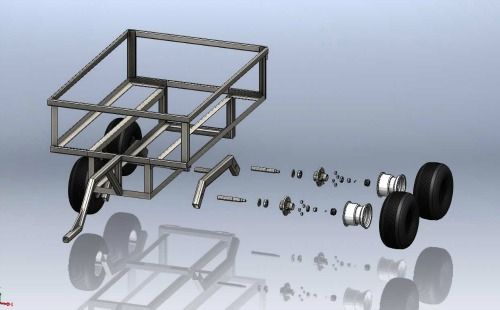 In this case, serious loads will fall on the entire structure, including the friction force.
In this case, serious loads will fall on the entire structure, including the friction force.
The plow and all its parts in contact with the ground (to maintain the necessary strength) must be made of iron with a thickness of at least 3-5 mm.
Share and knife are removable for timely replacement or sharpening. For their manufacture, it is best to use alloy steel of at least grade 9XC (it is used for the manufacture of circular saw blades). You can also use 45 steel with a hardness of HRC 50-55.
Blade can be made from an iron pipe with a diameter of 500-600 mm:
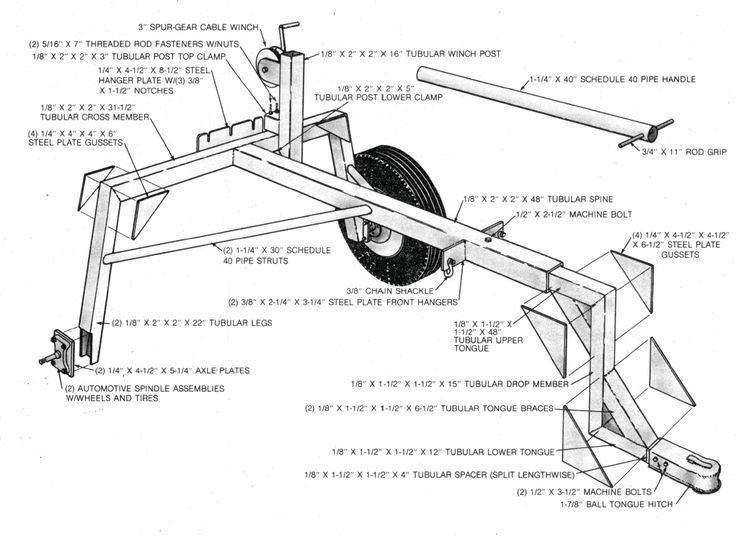
Remember:
Countersunk screws are used to connect all parts. Holes for them and threading are made in such a way that they provide a tight articulation of the parts, but make it possible to adjust the angles of the structure if necessary.
The exact dimensions, shape and angles of all parts are calculated based on the model and power of the ATV and the characteristics of the soil to be cultivated. If the power of the all-terrain vehicle allows, then after the plow you can immediately attach a harrow. Then after the passage you will get a ready area for planting horticultural crops.
If the power of the all-terrain vehicle allows, then after the plow you can immediately attach a harrow. Then after the passage you will get a ready area for planting horticultural crops.
Tillage with an ATV and a plow, made or bought, is not at all like cultivating with a tractor or walk-behind tractor.
This is an exciting activity comparable only to racing through the fields. You will get a lot of unforgettable sensations and make your life much easier, ennobling your garden at the same time and increasing the productivity of the land.
Reviews and comments on article
Interested in a ATV plow? Thinking of tilling the soil yourself? Now we will consider the main components and device of the plow, as well as whether it is possible to make a plow for an ATV in the garage with your own hands.
Residents of various quad rides! A variety of trips on these cars, of course, bring a lot of joy and adrenaline, somehow diversify your life. But you need to think about others. Let's take a little break from mental satisfaction and bring a little benefit to ourselves and help our families by using ATVs for agricultural purposes.
But you need to think about others. Let's take a little break from mental satisfaction and bring a little benefit to ourselves and help our families by using ATVs for agricultural purposes.
After all, a quadric is capable of creating miracles on any surface and even on soft ground. I suggest that an ATV can easily handle the plowing of the land in your garden, while spending a small amount of time by putting a plow for an ATV on it.
Many dachas have areas where tractors, in principle, cannot pass, or it is simply inconvenient for them to turn around there, to make some maneuvers. So the ATV in such cases has a colossal superiority over the tractor, having the ability to maneuver in difficult situations.
Just think about how much time and effort you spend in the spring on your vegetable gardens to till the soil. Believe me, the ATV will cope with the task of plowing one hundred percent. Quadr in its concept is universal and has proven itself in the agricultural industry for many years on the good side, and is an indispensable assistant for farmers. After all, he is able to replace a whole platoon of various agricultural equipment, with the use of the necessary accessories of course.
After all, he is able to replace a whole platoon of various agricultural equipment, with the use of the necessary accessories of course.
So, an ATV plow is a device that primarily includes a wedge that cuts the soil, a plowshare, a blade and a working surface. The design of the plow is a system of parts correctly matched to each other in order to perform all the functions of proper tillage. Let's analyze the purpose of each individual element, for the most complete representation of the entire process.
Wedge
Simple alpha wedge - under its action, the so-called soil deformation occurs, depending on the structure of the soil itself and the alpha angle α (located in Figure 1).
Dihedral wedge - gamma Fig.2 - together with the alpha angle, the wedge separates the captured layer from the bottom, lifting it, while compressing it in the vertical plane and splitting it into many separate parts. Note that the larger the alpha angle, the more the formation crumbles.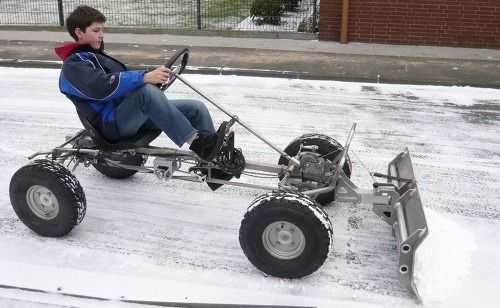 But look, do not go too far, if the angle is increased to 45 degrees, the earth will not slip and will gather in front of the wedge. So the gamma angle is located vertically and separates the wall of the furrow from the formation itself, while taking the earth aside.
But look, do not go too far, if the angle is increased to 45 degrees, the earth will not slip and will gather in front of the wedge. So the gamma angle is located vertically and separates the wall of the furrow from the formation itself, while taking the earth aside.
Dihedral wedge - beta Fig.3 - deflects the formation in the right direction and turns it over.
And so, as a result of connecting all three wedges, such a picture should be obtained (triangular wedge Fig.4). All this is needed to turn the reservoir from the horizon to an inclined position by changing the angle from 25 to 130 degrees.
A small conclusion: when the wedge moves along the X axis, the rib AB cuts the layer, separating it from the bottom, the rib BM from the wall, the ABM removes, crumbles and turns the layer.
Further, to ensure complete plowing, the wedge is, as it were, built up, and it is transformed into a so-called plowshare.
Ploughshare, in turn, is a moldboard, curved surface.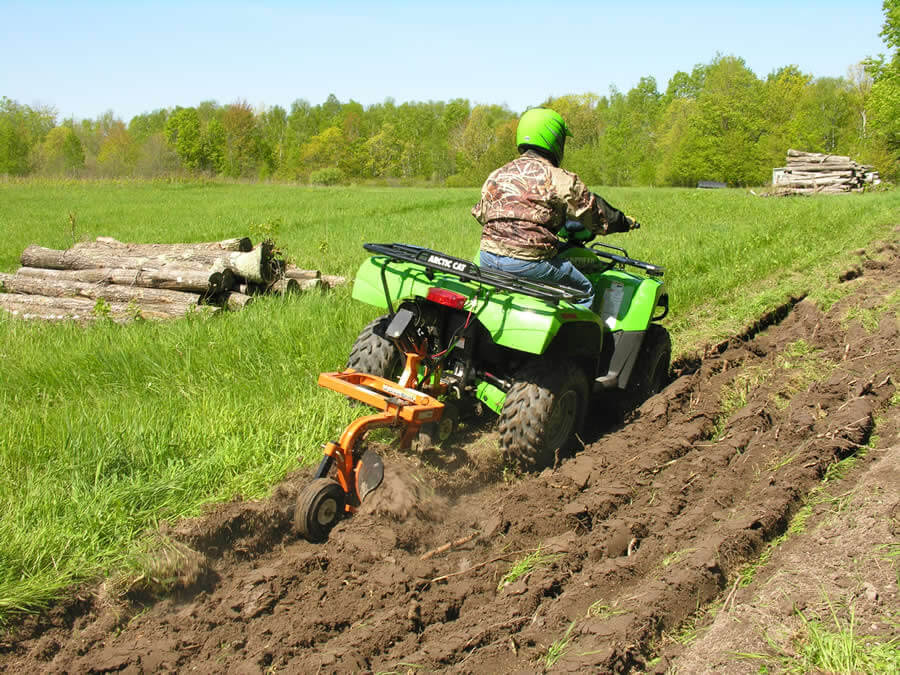 The recently listed alpha, beta, and gamma angles are constantly changing in this surface.
The recently listed alpha, beta, and gamma angles are constantly changing in this surface.
Let's take into account that the plow's organs, namely the workers, are the ploughshare, as we have already dismantled, consisting of a wedge and a plate extending it; blade wrapping the layer; a support board that serves as a limiter for the depth of plowing, which rests against the bottom of the furrow freed from the ground. These three listed parts and plus a rack for attaching them together make up the plow body.
In conclusion, about the above, we can draw a definite conclusion: from the first drawing to the last, a certain process of earth movement occurs - this body cuts off the layer, lifts, wraps, crumbles the earth and throws it into the previously freed open furrow. Fig.6
Quite a lot of people - farmers who prefer to design a plow for an ATV in the garage with their own hands. Why not, because this is a serious money saving, in our time the price of a plow can be about thirty-five or even forty thousand. Well, of course, branded factory plows will differ from home-made plows, clearly everything in size can be done by yourself, but this design requires it. But for plowing your gardens, even such a plow is enough for your eyes.
Well, of course, branded factory plows will differ from home-made plows, clearly everything in size can be done by yourself, but this design requires it. But for plowing your gardens, even such a plow is enough for your eyes.
And so let's consider a homemade plow for an ATV made by yourself.
Some plow developers, meaning at home, are trying to copy the design from a tractor plow or even from a horse plow. And you know, not everyone succeeds, not because laziness defeats their bonded mind, but only for a constructive reason, when developing, you need to clearly preserve the geometry of the hull.
Its formation comes from the considerations that when the earth is raised 20-25 centimeters high, the plow experiences quite large loads, and the surface, by the way, also feels significant friction, so we start from the thickness of the working parts of about 3-5 mm.
The share must be removable so that it can be removed for sharpening.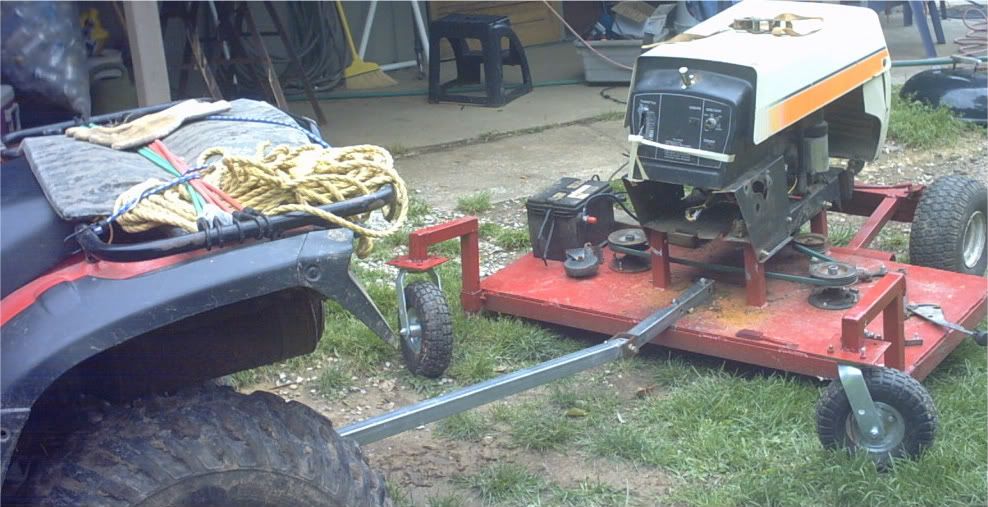 It is made of 9XC alloy steel, a circular disc is suitable. You can also use steel 45 hardness HRC 50-55.
It is made of 9XC alloy steel, a circular disc is suitable. You can also use steel 45 hardness HRC 50-55.
Let's consider the option of manufacturing a blade from sheet steel.
If you have bending rolls, drive the cut-out blank through them at an angle of 20 - 23 degrees to give a cylindrical surface, then finish it with a hammer.
If there are no rollers, it can be made from a steel pipe with an approximate diameter of 550 - 600 mm. And the thickness is 4-5 mm .. Before that, we will make a template from cardboard, put it on the pipe and mark it with chalk on the pipe, cut it out with gas welding, grind the errors on a knife. If necessary, finish with a hammer.
Next, we will act according to the saying: "Measure seven times, cut one." First, we will make elements from cardboard, preferably dense, we will draw up a visual layout of the plow, maintaining all angles. If you are satisfied with the layout, let's get to work with the hardware. Let me remind you the angle of alpha and beta from 25 to 130 degrees, gamma from 42 to 50 degrees.